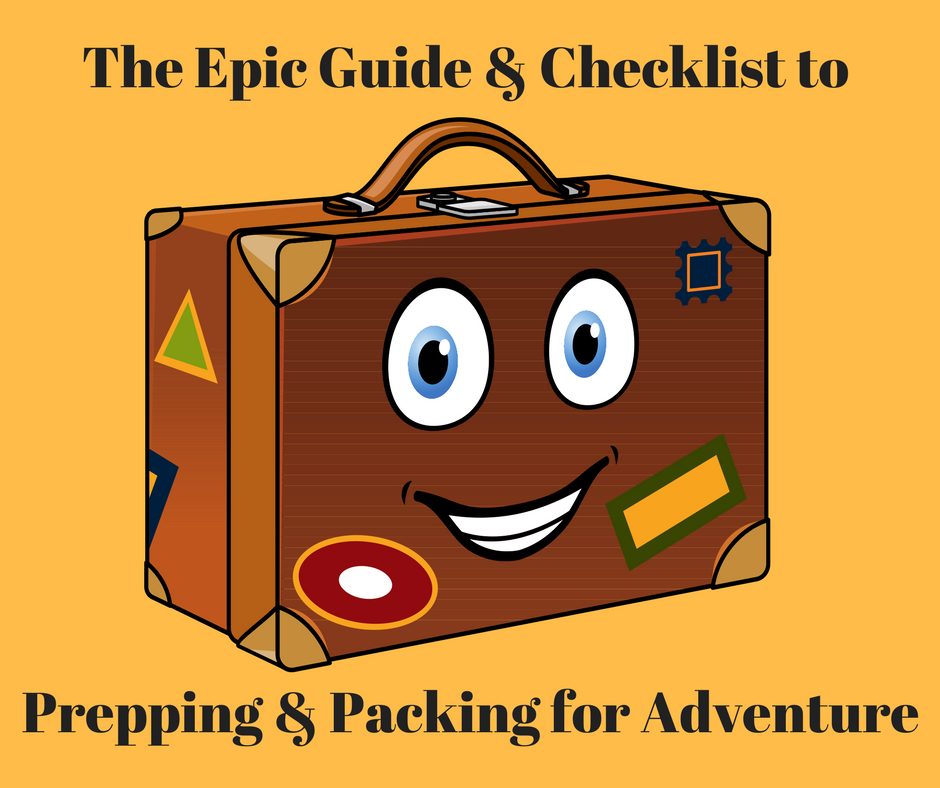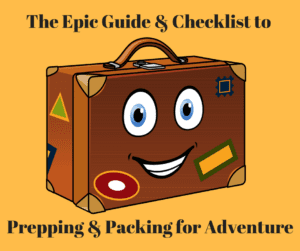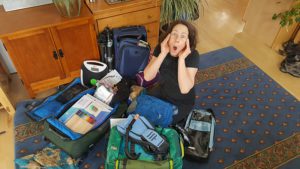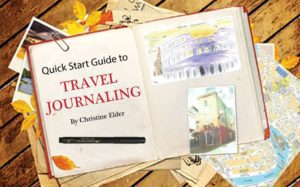It’s exciting to board a plane for a new adventure…but the planning and packing during the month before? Not so much. Personally, as a birdwatcher, I’d rather focus on learning the difference between the tanager species of Peru than fret about whether I’d remembered to renew my passport or was current on my vaccines.
If you’ve ever left your long underwear at home before a trip to see King Eiders on the Arctic tundra or forgotten to reserve an airport shuttle for your 4 a.m. departure to see the Crested Quail-dove in Jamaica, you’re not alone. This is the kind of thing that used to keep me up at night, tossing and turning as I worried about what I was going to forget to do or pack before the big day arrived.
But now I sleep like a baby. Pre-trip prepping is the key.
The Ultimate Guide to Packing for a Trip
I’ve traveled widely, especially over the last seven years co-leading birdwatching and nature sketching tours. I used to be nervous before trips, so much so it would literally take me a month to pack.
Eventually, I started following a pretty detailed packing checklist – this helped to alleviate my fears and streamline my packing routine. Over the years, my list evolved, and I started adding not only what to pack, but also what to do at home in preparation for leaving.
Nowadays, before each trip, I simply print my list and check off each item. This routine provides a safety blanket of sorts and saves me from reinventing the wheel each time I lug that Patagonia bag out of the closet. This has led to a deep sense of tranquility and best of all, no more sleepless nights.

I absolutely adore lists: making them and checking them off. And yes, I’m one of those folks who will make a list of stuff I’ve ALREADY done, just so I can put those pretty little check marks next to each item. So, as a frequent traveler, having a pre-made list that I can check off before each trip really streamlines the process and relieves the pressure of what is already a hectic affair. The peace of mind and tranquility I feel with the comfort of a list is priceless, so I wanted to share it with you!
Click to Download the Packing for Adventure Check List!

Packing insights from a lifetime of travel
I’ve been exceedingly lucky to travel globally throughout my life, from high school-sponsored trips to France and Hawaii, post-college trips to Turkey and Israel, to more recent birdwatching and nature sketching adventures, which have taken me from above the Arctic Circle to the equatorial rainforests of Borneo and Ecuador. I’ve learned from trial and error about what to pack over the years. My packing and prep list has been gleaned from my travels to 3 continents, 4 oceans, 14 countries, 5 island nations, and 26 U.S. states. Of course, this pales in comparison to many folks, but heck, I’ve got a lot of years to travel left in me, so I will continue to share my discoveries as I go through this journey called life.

Disclaimer! My list is not for everyone!
I’ve been pondering whether I should share my packing list for quite a while, fretting over whether my personal list will reveal some deep-seated psychological issues that I should probably keep to myself (LOL). And while I’ve left a few of the most personal items off of this public list, it will still reveal my obsessive need to be prepared for any and all misadventures, and with all my creature comforts included (yes, I must have my hair scrunchie and my Starbucks instant coffees!) And though a person’s packing style is a very personal choice, there are items to pack and things to do before a trip that are nearly universal. The focus of my packing list is on comfort, safety, and flexibility.

Who this list is and isn’t for
While the focus of my travel packing and prep list is on the kind of longer, international, nature-focused trips I most often take part in, many of the items and preparatory steps are the same whether you’re spending a week at a spa in Sedona or a month in the Atacama Desert. And as a woman, of course, there are some lady-specific items, but I’d say 98% of the list applies to any gender. However, my list doesn’t address the specific needs of folks bringing children, pets or disabled persons on a trip, so you’ll need to adjust accordingly.
My list doesn’t cater to the likes of 30-something Millennials who want to be digital nomads, sports adrenaline junkies out to bag the next peak, nor the Pina colada sipping cruise ship aficionados set.

My planning and packing checklist
Although my packing list is exhaustively long, in reality, there are only two categories of things I believe that one must pack. Everything else that you might leave or forget can be found at your destination (yes, people need toothpaste in Vietnam too!) So, the two categories are:
- Essential must-haves. Passport, ID cards, prescription medications, and eyeglasses, stash of emergency cash in small bills. A list of emergency contacts and essential passwords. My binoculars and smartphone are also essentials on the list, as are my nature sketching supplies.
- Creature comforts. These are things that you probably could find locally on your trip, but might be quite time consuming and/or expensive to seek out. For me, these include favorite snacks and drinks (especially important if you have a dietary restriction like being vegan or gluten-free). Plus, I have this irrational fear of being stuck on the tarmac for hours without food (I get very ‘hangry’ when I’m famished!) A headlamp is another item that is hard to find while traveling, but extremely handy for nocturnal explorations and for serving as a hands-free flashlight; and who couldn’t use more hands while traveling?
Most people err on the side of bringing too much on a trip and I’m often guilty as charged. I find that clothing is my weakness. Not that I’m a fashionista; I just yearn to be prepared for EVERY possible weather and trail condition. I can usually get away with a lot fewer items, since I do handwashing nightly in my room, especially in hot climates. Besides, it’s fun to save space in your luggage for that special piece of clothing that you can only get at the local market or bazaar; like leather sandals in Mexico, a cashmere scarf in Thailand, or a fez in Turkey, all of which will help you blend in with the local crowd (well maybe not the fez, tee hee).
Things I no longer pack
I’m not a big fan of those round-the-neck passport holders. Ditto fanny packs. Ditto money belts. Sorry, I think they look ridiculous, aren’t that convenient, and scream TOURIST. Instead, I keep my passport, ID and some money in a side pocket of my slacks. I don’t bring an umbrella, too big and fussy to use. No girly stuff like fancy jewelry, makeup, hairdryers, clothes irons. I no longer like those zippered pants that convert to shorts; I find the mid-thigh zippers to be irritating when seated. And the more I travel, the more I’ll prune my list, being ever more demanding that the items on it are practical, durable, multi-use, or simply give me comfort and joy.

Recommendations for the first aid kit
I’ve truly been blessed with good luck (fingers crossed), having experienced very few health-related mishaps while traveling. Not counting the food poisoning in Turkey that laid me up for a week (easily prevented if I would have vetted my food source more carefully…that meat cooler didn’t look very cold!), and I seem to be a magnet for jellyfish: I’ve been stung on the hands and face in the Mediterranean, Caribbean, Pacific and South China Sea (so now I always wear a bodysuit and carry StingEze).
However…. A few years back, we were in a Central American country on a birding trip and a friend that was with us (name has been withheld to protect the innocent) tripped and broke his/her ankle while trying for a better view of that Russet-crowned Motmot. It’s amazing how just a moment’s carelessness can turn into a ruined vacation, excruciating pain, months of lost work (especially if you have a physically active profession), not to mention thousands of dollars of expenses (hot tip: NEVER travel without travel insurance, such as Allianz or TravelEx).
After this incident, I thought it well-advised to become more prepared for emergencies, beyond the simple first aid/CPR certifications that guides are required to have. So, I became Wilderness First Aid certified in 2015. I highly recommend this training, which I received from the National Outdoor Leadership School, though you may find similar programs through your local American Red Cross or community college.
My first aid kit
I assembled my kit based on the recommendations of the above course, as well as the lists provided in wilderness first aid manuals, coupled with my own experiences and specific needs. I keep a copy of my first aid kit list with my field kit, and I recheck all the items each time I pack for a new trip. And if I need to use the kit while traveling, I leave a note in the kit about what items I used that will need replacing upon my return. Feel free to print this out. If you have any suggested additions, I’d love to know!
Just a little prep can go a long way toward ensuring safe and enjoyable trips. You wouldn’t want to get all the way to Peru or Egypt only to have a blister prevent you from hiking the archaeological ruins when a simple square of Moleskin could have saved the day!
And remember, all your work prepping the perfect first aid kit will be useless if it’s not with you in the field. So, don’t forget it in your cabin or vehicle when you’re taking a hike. If I’m planning a short stroll, and other folks are with me, I might only bring an abbreviated first aid kit, but when I embark on longer, or solo hikes, or those in extreme weather, this warrants bringing the full kit at all times. My downloadable Packing List includes my recommended first aid and medical supplies.
Don’t forget your four-legged companions
First aid kits are also helpful if you’re being accompanied in the field by your canine companion, pack mule or llama. Of course, many of the medications aren’t appropriate for your four-legged friends, but there are specific first aid kits you can assemble just for them. I highly recommend the richly illustrated guide The First Aid Companion for Dogs & Cats by Amy D. Shojai, which is an invaluable resource for both home and travel, complete with a chapter on your pet’s essential medicine chest. Once my dog, Owsley, cut his footpad nearly in half while swimming, and another time he nearly died from eating something in the wilderness and had to be carried out on an improvised stretcher! It’s one thing to forget a first aid kit for yourself, but you might feel really guilty if your animal sickens and you’re left high and dry.
Pre-trip planning
Prepping early for a trip is half the battle, especially if you are a ‘Nervous Nellie’ traveler as I once was. In fact, I recommend you take care of the following even if you have no firm plans for an upcoming trip. You never know when an unexpected adventure awaits. For example, once I had one day’s notice to go on a SCUBA diving trip at a rock-bottom price because a friend who had planned to go backed out at the last minute for a family emergency. Needless to say, I went!
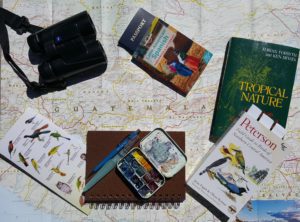
Prepping for a fast get-away
- So, always do the following in advance (weeks to months) of any possible window of travel opportunity to enable a fast, stress-free getaway at a moment’s notice. And especially nowadays, with all of the recent fears and travel restrictions, it’s good to be doubly prepared.• Have your passport, driver’s license, International driver’s license, first aid certifications, and other ID documents up to date.
• Be current on physical exams and vaccines (you’d hate to have a lingering toothache turn into an extraction in a 3rd-world country!) Your family doctor can give you a wellness exam that includes recommendations from the Centers for Disease Control and Prevention for vaccines to be current on.
• Have an extra backup supply of any medications, vitamins, and supplements, including those specifically for travel that you need a prescription for, like Cipro for bacterial infections and Hydrocodone for pain. You should have at least several days’ supplies of scripts & meds to hold you over in case of travel emergencies and flight delays.
• Create a schedule and to-do list for your house sitter/pet sitter/plant sitter, and have someone in mind that you trust. Once I came home to a house full of dead orchids because the sitter left them outside overnight (the vanilla plant death was heartbreaking!) Make an extra house key and be sure your sitters have it or know where it’s hidden.
• Create an emergency contact list, then make a copy to bring with you and a copy to leave at home.
• Study your favorite language on an ongoing basis so you’ll be ready to say ‘Gracias’ and ‘Merci’ like a local (like Duolingo, which is fun and free.
• Have a packing checklist ready to go (for example…mine!) I love being able to quickly print out my checklist for each trip and not have to reinvent the wheel each time.
• Purchase any non-perishable items from that list.
• Have your bag packed and ready to go with the essentials. This can double as an emergency ‘go bag’ in case of a natural disaster near your home — think fire, flood, earthquake and the like.
• Check all baggage for up-to-date luggage tags, and proper functioning of wheels and zippers. Add a unique identifier to each, like a colorful ribbon or stickers. Make sure to measure your luggage to double-check that it conforms to airline restrictions. And even if your carry-on luggage is the correct size, it may be too big for the overhead compartments of smaller aircraft going to islands and remote destinations, so be sure to check. My buddy, Chase Reeves, does incredible bag reviews on his YouTube Channel, including one on a Patagonia bag I use, that you may find useful. - Consider applying for a credit card that gives you points towards travel. We use the highly-rated Alaska Airlines Visa Signature card. Make a dent in any existing credit card balances so you’ll have plenty for emergencies.
• Consider installing the smartphone app, Mobile Passport. It speeds you through U.S. Customs when re-entering the USA (currently available for 21 airports nationwide). It’s so cool and fast, you might feel like you’re cheating and (almost) feel sorry for those other folks waiting in the loooooooong lines!
• Consider applying for Global Entry and TSA PreCheck. All applicants undergo a rigorous background check and in-person interview before enrollment (we haven’t done it but know folks who have. - Research apps that make travel easier. I love Skype for keeping in contact with friends via video, calls and messaging. Best of all, it’s free!
More tips for once your date is set for travel
- When making your flight reservations, request a special meal (they are often fresher and tastier). Also, choose your seat based on the potentially best view out the window, and to avoid the hot, afternoon sun.
- Consider joining a private airport lounge, like Alaska Airlines’ Lounge or Delta’s Sky Club. They may sound hoity-toity (as my mother used to say) and expensive, but can quickly make up for their price, especially on a long international layover, where you might otherwise be tempted to just spring for a hotel (and don’t forget the cost of a cab and meals.) Instead, with a lounge membership, you can simply waltz right up to one and enjoy the multiple and welcome amenities like free drinks (including cocktails!), snacks, WIFI, office space, and comfortable lounge chairs for napping, plus free magazines and TV. Some even have private showers and bathrooms that will make a world of difference, especially when you are heading home from a long, international trip, and perhaps are rundown and burnt out. In this scenario, you would gladly pay three times the price for the comfort and quiet of a service like this. Some lounges even offer a last-minute day pass option.
- Visit website travel forums for a wealth of information on packing, destination, and travel tips. Two of my favorite are Lonely Planet and Rick Steves.
- Poll your friends on social networks. I’m certain you’ll find plenty of folks who’ve visited your dream destination and would be more than happy to spill the beans on their favorite activities and restaurants!
- For Pete’s sake, leave room for souvenirs! I’ll never forget the spectacle that I and my partner made in Rome’s Fiumicino Airport, where we realized we were WAY overweight at the end of our three-week trip to the Italian islands. We were on the floor, frantically tossing into the garbage can our guidebooks and other bulky and heavy items in order to make room for our precious cargo of Corsican myrtle liquor, Sardinian bottarga, and Sicilian seashells. We made a hilarious sight!
Here are some other stories you might like
Lastly, if you just can’t get away, watch my video below on creative ways to “travel” in your own town!
Did You Enjoy This Story?
If you’ve found value in this story and believe in my mission to educate youth and adults alike on the value of nature, I invite you to make a donation to help broaden and deepen the work I can accomplish.
Click the Paypal ‘Donate’ button below to donate any amount you wish to support the conservation and education work I do. You don’t need to have a Paypal account to donate, you may also choose to use a credit card, or simply send put a check in the mailbox if you wish. Thank you!

